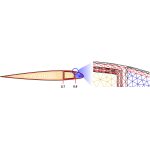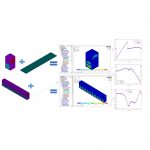NAFEMS Webinar Now Available Online on Revolutionary Multiscale Approach to Bridging Materials Genome and Structural Analysis for Composites
The webinar by AnalySwift CTO Dr. Wenbin Yu on Structure Genome (presented through NAFEMS on February 28, 2017) is now available online. The webinar, “Structure Genome: A Revolutionary Multiscale Approach to Bridging Materials Genome and Structural Analysis,” aimed to fill the gap between materials genome and composite structural analysis using a new concept called Structure Genome (SG). The Mechanics of Structure Genome theory underlies AnalySwift’s powerful SwiftComp composites modeling software, which provides for unified modeling of composite beams, plates/shells, and 3D structures.
NAFEMS members may watch the original webinar through the NAFEMS website here. Those interested in viewing the webinar who are not members of NAFEMS may download the slides on the cdmHUB (Composites Design & Manufacturing Hub) website. After creating a free log-in to cdmHUB, the slides may be accessed here. Below is an overview of the webinar materials.
Materials Genome Initiative (MGI) aims to deliver the required infrastructure and training to accelerate discovery, developing, manufacturing, and deploying of advanced materials in a more expeditious and economical way. However, material by definition is a matter from which a thing can be made of. Ultimately speaking, it is not the material performance, but the structural performance or rather system performance we are after. Thus, materials genome must integrate with structural analysis to maximize the benefits of accelerated development of advanced structural materials.
To fill the gap between materials genome and composite structural analysis, a new concept, Structure Genome (SG) is proposed. SG acts as the basic building block connecting materials and structures and contains all the constitutive information needed for a structure the same fashion as the genome contains all the intrinsic information for an organism’s growth and development. The Mechanics of Structure Genome (MSG) represents a revolutionary approach to multiscale modeling drastically different from the conventional bottom-up multiscale modeling approaches. The principle of minimum information loss (PMIL) is used to avoid a priori assumptions commonly invoked in other approaches and decouples the original problem into two sets of analyses: a constitutive modeling and a structural analysis. The structural analysis can be routinely performed in commercial FEA software. MSG confines all approximations to the constitutive modeling which can construct constitutive models for all types of structures including 3D solids, 2D plates/shells, and 1D beams, directly linking the structural properties with microstructural details. When specialized to 3D structures, this approach provides a general-purpose micromechanics theory which can provide a better alternative to the RVE analysis and asymptotic homogenization theory in terms of efficiency, accuracy, and versatility. MSG provides a unified treatment for all microstructures (periodic, aperiodic, partially periodic). With MSG, multiscale constitutive modelling is simplified to answer three fundamental questions: 1) what is the original model needed for capturing relevant physics? 2) what is the model wanted for a particular design? 3) what is the SG? With answers of these three questions, MSG allows one to choose the starting scale and ending scale and capture details as needed and affordable.











